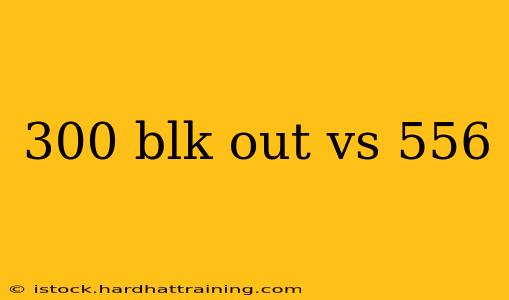300 Blackout vs. 5.56: Which Caliber Reigns Supreme?
Choosing the right caliber for your firearm is a crucial decision, impacting everything from accuracy and range to stopping power and recoil. This detailed comparison of the 300 Blackout and 5.56 NATO cartridges will help you understand their strengths and weaknesses, ultimately guiding you towards the best choice for your needs.
Understanding the Contenders: 300 Blackout and 5.56 NATO
The 300 Blackout, also known as .300 BLK, is a relatively new cartridge designed for shorter-barreled rifles (SBRs) and pistols. Its primary advantage lies in its ability to deliver impressive stopping power at shorter ranges, even with suppressed configurations.
The 5.56 NATO, on the other hand, is a widely-used, battle-proven cartridge known for its longer range and flatter trajectory. It’s a staple in military and law enforcement applications worldwide.
Key Differences: A Head-to-Head Comparison
Let's delve into a point-by-point comparison to highlight the key differences between these two popular calibers:
1. Range and Trajectory:
-
5.56 NATO: The clear winner in terms of range. Its higher velocity translates to a flatter trajectory, making longer-range shots more accurate. Expect effective range to extend considerably beyond that of the 300 BLK.
-
300 Blackout: Designed for shorter ranges, the 300 BLK is significantly less effective at distances beyond 300 yards. Its trajectory drops more rapidly, requiring more precise aiming adjustments at longer ranges.
2. Stopping Power:
-
300 Blackout: Generally boasts superior stopping power at close to medium ranges, especially with heavier subsonic ammunition. The larger diameter bullet delivers greater energy transfer upon impact.
-
5.56 NATO: While less powerful at close range, the 5.56 NATO's higher velocity contributes to effective stopping power at longer ranges, where the 300 BLK starts to falter.
3. Recoil:
-
300 Blackout: Typically experiences lower recoil, making it more manageable, particularly for new shooters or those with less upper body strength.
-
5.56 NATO: Recoil is noticeably more pronounced compared to the 300 Blackout, especially with full-power ammunition.
4. Suppressed Use:
-
300 Blackout: Subsonic ammunition specifically designed for the 300 BLK is readily available, making it ideal for suppressed applications. This reduces noise significantly, improving stealth and hearing protection.
-
5.56 NATO: While suppressors can be used with 5.56 NATO, the results aren't as effective compared to the 300 BLK's subsonic ammunition.
5. Ammunition Availability and Cost:
-
5.56 NATO: Widely available and generally more affordable, due to its extensive use in military and civilian markets.
-
300 Blackout: While increasingly popular, ammunition can sometimes be more expensive and availability may vary compared to the readily available 5.56 NATO.
6. Applications:
-
5.56 NATO: Best suited for applications requiring longer-range accuracy, such as hunting medium-sized game at longer distances or competitive shooting.
-
300 Blackout: Ideally suited for home defense, close-quarters combat (CQB), hunting smaller game at closer ranges, and situations where sound suppression is crucial.
The Verdict: Choosing Your Champion
The "better" caliber ultimately depends on your individual needs and intended use. The 5.56 NATO excels at longer ranges and boasts greater availability, while the 300 Blackout shines in close-quarters scenarios and suppressed applications. Consider your priorities—range, stopping power, recoil management, and sound suppression—to make an informed decision. Thorough research and potentially even range time with both calibers can solidify your choice.
